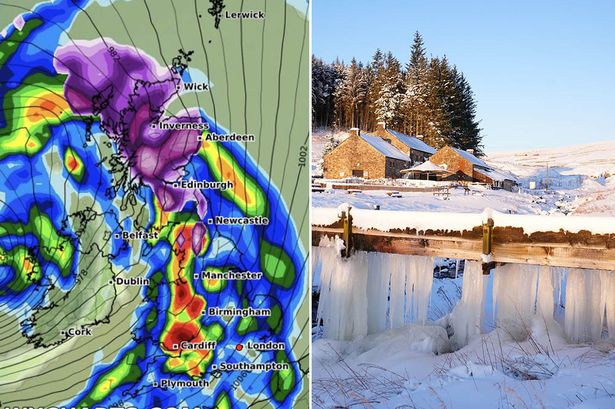The latest weather models are painting a dramatic picture of a potential widespread snow event across the United Kingdom later this month, hinting at a significant Arctic blast that could blanket the nation in a thick layer of snow within a mere 30-hour period. While long-range forecasting carries inherent uncertainties, these projections suggest a powerful cold snap capable of delivering intense snowfall rates, reaching up to 15 centimeters per hour in some areas. This rapid accumulation could lead to significant disruptions, impacting travel, infrastructure, and daily life across the country. The severity of this potential event necessitates close monitoring and preparedness for the potential challenges it poses.
The predicted snow event is attributed to a significant shift in atmospheric patterns, with a strong northerly or northeasterly airflow drawing frigid Arctic air directly over the British Isles. This cold air mass, combined with ample moisture, creates ideal conditions for heavy snowfall. The intensity of the snowfall, with potential rates of 15 centimeters per hour, is particularly concerning. Such rapid accumulation can quickly overwhelm snow removal efforts, leading to hazardous road conditions, closures of transportation networks, and potential power outages due to the weight of the snow on power lines and trees.
The anticipated widespread nature of this snow event is also notable. While the UK often experiences localized snowfall, particularly in northern and higher elevation areas, the current models suggest that even southern regions, typically less accustomed to heavy snow, could be significantly impacted. This expansive snow cover would pose wide-ranging challenges, disrupting not only transportation but also potentially impacting essential services such as healthcare and supply chains. The duration of the event, compressed into a 30-hour window, further amplifies the potential for disruption, leaving limited time for mitigation and recovery efforts.
The potential impacts of such a substantial snowfall are multifaceted and far-reaching. Firstly, travel disruptions are almost certain, with road closures, flight cancellations, and train delays highly likely. The rapid accumulation of snow can make roads treacherous and impassable, stranding motorists and hindering emergency services. Airports may be forced to suspend operations due to reduced visibility and challenging runway conditions. Rail services are also susceptible to disruptions, as heavy snow can affect signaling systems, overhead lines, and track conditions.
Beyond transportation, the intense snowfall could also disrupt daily life for millions. Schools and businesses may be forced to close, impacting productivity and childcare arrangements. Power outages are a possibility, with the heavy snow potentially downing power lines, leaving homes and businesses without electricity. Access to essential services, such as healthcare facilities, could become challenging, requiring careful planning and resource allocation. Furthermore, the elderly and vulnerable populations are particularly susceptible to the dangers of extreme cold and snow, requiring community support and assistance.
While the specific details of this projected snow event remain uncertain, the intensity and widespread nature indicated by the current weather models warrant serious attention. It is crucial for individuals, communities, and authorities to remain vigilant and prepare for the potential challenges posed by such a significant weather event. This preparation may involve stocking up on essential supplies, ensuring homes are adequately insulated, and developing contingency plans for travel and potential power outages. Monitoring weather forecasts closely and heeding any warnings issued by authorities is essential for staying informed and safe during this potential Arctic blitz. Furthermore, community support and coordination will be crucial in assisting vulnerable populations and ensuring a collective and resilient response to this potential weather emergency.














